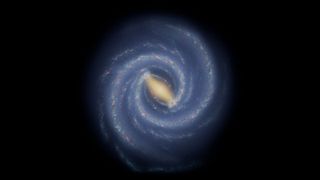Earth's perilous journey through the Milky Way's spiral may shape the planet's geology
Every 200 million years, high-energy comets may pelt our planet as it passes through our galaxy's spiral arms.

Earth's journey through the Milky Way may have had a profound impact on our planet's geology. New research indicates that every 200 million years, when Earth passes through its galaxy's spiral arms, the planet is pummeled with high-energy comets, and this bombardment may thicken Earth's continental crust.
The team behind the new findings thinks the dense clouds of gas in the spiral arms interact with comets at the edge of the solar system, sending them hurtling toward Earth.
"As geologists, we normally think about processes internal to the Earth being really important for how our planet has evolved," Chris Kirkland, a geologist at Curtin University in Australia and lead author of the study describing the findings, said in a statement. "But we can also think about the much larger scale and look at extraterrestrial processes and where we fit in the galactic environment."
Related: Earth's oldest crystals reveal age of plate tectonics
The team reached their conclusion by examining zircon crystals from two of Earth's oldest continents and regions, where the planet's earliest continental history is preserved: the North American Craton, in Greenland, and the Pilbara Craton, in Western Australia.
The decay of uranium in zircon crystals in these regions has been used to create a geological timeline spanning 1 billion years, from 2.8 billion to 3.8 billion years ago, during the Archean eon. This timeline could help geologists discover how Earth became the only planet known to have continents and active plate tectonics.
Isotopes of the element hafnium in zircon enable scientists to spot periods in Earth's history that experienced an influx of juvenile magma — magma containing elements that have never reached the surface before — a sign of crust production.
Get the Space.com Newsletter
Breaking space news, the latest updates on rocket launches, skywatching events and more!
Kirkland and his team found that over a long timescale, patterns of crust production corresponded with galactic years . (A galactic year is the time it takes the sun to complete an orbit around the center of the Milky Way.) These findings were further supported by examinations of oxygen isotopes, which revealed a similar pattern.
Therefore, Earth's journey around the Galactic Center helps shape the planet's geology, the team concluded.
Earth's journey around the Galactic Center
Not only does the solar system travel around the Galactic Center, but the spiral arms that radiate from it also turn, albeit at a different rate.
The sun orbits the Galactic Center at around 536,000 mph (863,000 kph), while the spiral arms turn at approximately 47,000 mph (76,000 kph). This means the sun and the solar system, as well as many of the Milky Way's other stars, move in and out of the spiral arms, much like fans doing "the wave" at a stadium.

When the solar system moves into the spiral arms, icy planetesimals in the Oort cloud at its outer edge (around 4.6 trillion miles, or 7.4 trillion kilometers, from the sun) interact with dense gas clouds of the whip-like arms, sending icy material hurtling toward the inner solar system — and our planet.
These objects arrive with more energy than the asteroids that regularly pelt Earth. Most of those space rocks come from the main asteroid belt between Mars and Jupiter , a region that is much closer to Earth than the Oort cloud is.
"That's important, because more energy will result in more melting," Kirkland said in the statement. "When it hits, it causes larger amounts of decompression melting, creating a larger uplift of material."
The influence of impacts on rock formation and increased crustal generation was also apparent in the team's examination of spherule beds, which are deposits of small spheres created by ejected material that cools, condenses and falls back to Earth after impacts. Spherule beds were also correlated with Earth's passage into the Milky Way's dense spiral arms between around 3.3 billion and 3.5 billion years ago, when the planet was just over 1 billion years old.
Determining the ages of more deposits in spherule beds could further support the team's findings and, in turn, encourage geologists and astrophysicists to start thinking more about the influence of Earth's wider cosmic environment on the planet's geology.
"It's very hard to prove these things; we want to make that link and start the conversation to look at geological processes beyond the Earth, beyond the solar system, and what might drive those," said study co-author Phil Sutton, a lecturer in astrophysics at the University of Lincoln in the U.K. "We didn't just form in isolation."
The team's results were published online Aug. 23 in the journal Geology.
Follow us on Twitter @Spacedotcom or on Facebook.
Join our Space Forums to keep talking space on the latest missions, night sky and more! And if you have a news tip, correction or comment, let us know at: community@space.com.

Robert Lea is a science journalist in the U.K. whose articles have been published in Physics World, New Scientist, Astronomy Magazine, All About Space, Newsweek and ZME Science. He also writes about science communication for Elsevier and the European Journal of Physics. Rob holds a bachelor of science degree in physics and astronomy from the U.K.’s Open University. Follow him on Twitter @sciencef1rst.
